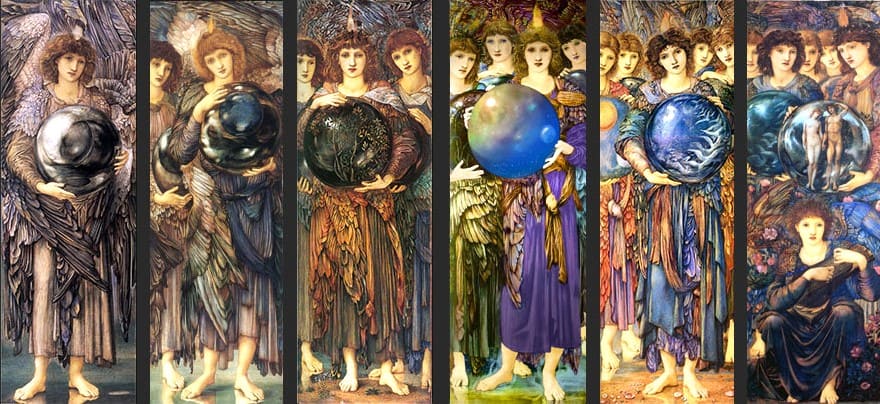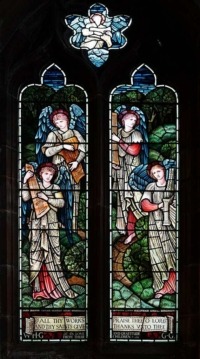You might think that an artist who paints sacred art does so out of a profound sense of faith, and in that you would be mostly correct. We have only to look at the many centuries of Christian artists who have expressed their faith in artistic beauty to know that this is true.
 Fra Angelico (1395-1455), for example, would kneel down to pray before taking up his brush every morning, asking God to bless and multiply his works for the evangelization of souls. That holy Dominican friar is the patron saint of Christian Artists.
Fra Angelico (1395-1455), for example, would kneel down to pray before taking up his brush every morning, asking God to bless and multiply his works for the evangelization of souls. That holy Dominican friar is the patron saint of Christian Artists.
No Definite Relationship
But not every creator of religious art has the faith of Fra Angelico or of the centuries of holy iconographers who proceeded him. The Catholic philosopher, Etienne Gilson, put it this way:
A painter can be a deeply religious man, even a saint, but the number of painters indifferent to religion is very great. Italian masters of the Renaissance painted what they were asked to paint; some of them were pious men, others were notorious unbelievers or, at least, suspected of unbelief. At any rate one does not detect any definite relationship between artistic talent and religious faith. (The Arts of the Beautiful, 171-172.)
No definite relationship between artistic talent and faith. Interesting, right?
That’s the kind of perplexity I felt when I read about the Victorian artist, Edward Coley Burne-Jones (1833-1898) whom I consider to be the greatest angel artist since Fra Angelico. Here are just a few examples of his work.
A Lost Faith
Apparently, he had been raised in a Christian household but had lost his faith like so many of the so-called intellectuals and artists of his day. He was even known to scoff at organized religion when asked his opinion on the matter. Again, interesting, and quite sad.
Yet, as one writer explained, Burne-Jones retained his love for a kind of “Christmas carol Christianity” all his artistic life. The writer is a fellow Brit and commented rather nostalgically that “Christmas would not be Christmas without a Burne-Jones angel.”
Well there is that, but like so many people in our own watered down Christian society, he loved just the attractive parts of religion: Good Friday Christianity was not as appealing.
However, I pray for those Christians who don’t embrace the full truth of the faith and even for those who reject faith altogether. And that, I think, is one of the many reasons why we need angels.
Angels are sacred windows in their own ways, able to penetrate the souls of irreligious people with transcendent beauty. I truly believe they have a role in inspiring excellent religious art, no matter the motive of the artist. The patron saint of artists is named, Angel-ico, after all.

Several Movements
Burne-Jones was a prodigious talent, an artistic genius in fact. He was active from the mid-1850s to the end of the century, and, in a sense, he was a Renaissance man of a latter day.
He was not just a painter but became accomplished in virtually every art form available to him: illustration, painting (in a variety of mediums), mosaics, tapestries, and stained glass. He even created furniture, stage sets, and costumes for the theater!
 He came of age during a period in English history where artists were reacting against the hyper-materialism of the Industrial Revolution and the formalism of religious art of past centuries. Here are the various artistic currents that inspired him:
He came of age during a period in English history where artists were reacting against the hyper-materialism of the Industrial Revolution and the formalism of religious art of past centuries. Here are the various artistic currents that inspired him:
- The Arts and Crafts Movement (led by William Morris, who was his great friend and collaborator; the two are pictured above with Burne-Jones at left and Morris on the right.)
- The Pre-Raphaelite Movement (a reaction to the rules and formalism of the Renaissance—named after the artist Raphael; it sought a return to nature and naturalistic styling, even in religious art).
- The Aestheticism Movement (rejected the moral messaging of most religious art and advocated excellence in craftsmanship instead.)
- The Symbolist Movement (sought to express truth through symbols and metaphors in new settings rather than traditional religious scenes).
It’s hard to imagine an age which featured a greater quantity and diversity of artistic currents. It’s also hard to identify Burne-Jones with any one of these movements exclusively. His talent was so vast in scope that he participated in each one of them but surpassed them all by the sheer versatility of his creations.
The motto of all these artistic movements is a singular phrase that captures their work ethic: “Art for Art’s Sake.” Thus, the general climate in which Burn-Jones created so many masterpieces may explain why his religious artwork was so beautiful but not an expression of faith, as such.
Angel Artist
We can’t cover his amazing array of art in our limited format, so I’d like to just focus on his angels. They are unique and magnificent!
Burne-Jones made four separate trips to Italy in the course of his career, and his angels reflect his deep exposure to Italian art. Even though the artistic movements of the day eschewed Renaissance rules of composition, they loved Renaissance styles! A host of the greats like Botticelli and Michelangelo would have been very much at home with these Burne-Jones angels!
Let’s do a brief survey of some of the most amazing examples of them.
Mosaics
The main Protestant church in Rome, St. Paul Inside the Walls, holds one of the most extraordinary examples of his mosaic angels.
Paintings
On the feast of Epiphany I wrote about Burne-Jones’s famous, monumental “Star of Bethlehem” watercolor painting (he also created a tapestry version). There are hundreds more angels he painted in various mediums, especially which are simply ravishing, even in small and inadequate reproductions like these:

Stained Glass
Burne-Jones’s stained glass angels are radiantly beautiful, particularly because he chose to depict them in deep and vibrant colors not traditionally associated with angels. These two (of the thousands he created) are particularly striking.
Tapestries
As noted, the artist often turned versions of his paintings into woven wonders, not the least of which are the two sets of angel tapestries he crafted for Salisbury Cathedral: the “Ministering Angels” (Angeli Ministrantes, 1894) and the “Praising Angels” (Angeli Laudantes, 1898).
Can Angels Save Us?
While the obvious answer to this question is that only Jesus saves us, it is also clear from scripture that the Lord used (and continues to use) angels to save and  rescue people. The Chicken Soup for the Soul series has at least three books detailing stories of angels who rescue people!
rescue people. The Chicken Soup for the Soul series has at least three books detailing stories of angels who rescue people!
Think also of the angels who saved Lot from the fate of Sodom and Gomorrah (Gen 19); the angel who saved Isaac from sacrifice (Gen 22), and the holy ones who saved the Temple from desecration (2 Macc 3).
Yes, angels can save people in a subordinate sense because God has tasked them to “light and guard, to rule and guide” us and perhaps even knock us back onto the straight and narrow when we go astray. Which leads to a question about our subject:
Did the angels save Burne-Jones from the fate of the faithless?
I don’t know, but I certainly pray he made it to heaven despite his expressed unbelief in his younger days. Burne-Jones, like so many others, mistook beauty as an end in itself. It is instead a sacred window pointing to a greater Beauty beyond this world.
And if he made it to heaven, there were likely a few strong spiritual beings who wrestled him across that threshold.
—
Photo Credits: Artwork in the public domain: Photo with Morris; Fra Angelico Angel; St. Paul Dome Mosaic; Angeli Laudantes; Angeli Ministrantes; Annunciation; Nativity; First Angel Playing Instrument; Second Angel Playing Instrument; Angels at the Resurrection; Last Judgment; Angels Carrying St. Bridget; Days of Creation: Feature picture (Day 1) and Angel with Globe (Day 2). Also, Angel Musicians (kitmasterbloke via Wikimedia Commons).




















Leave A Comment